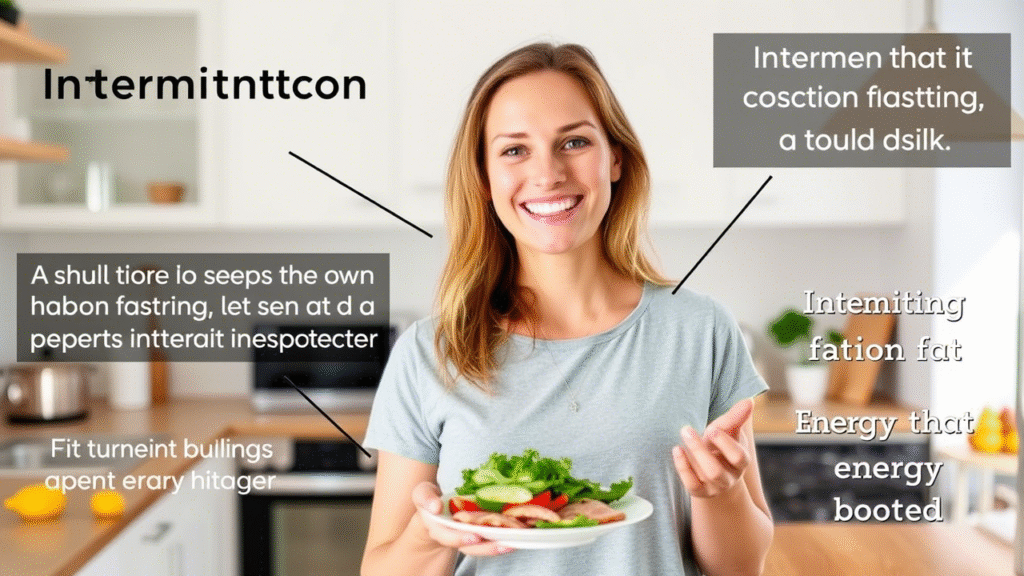Discover powerful intermittent fasting tips for fat loss and increased energy. Learn how to structure your fasting routine, manage hunger, boost metabolism, and maintain long-term health.
Introduction
In a world overloaded with diet trends and quick fixes, intermittent fasting has emerged as a powerful and sustainable way to lose weight fast, burn stubborn fat, and boost energy levels naturally. More than just a fad, intermittent fasting is backed by science and practiced by millions around the world. Whether you’re a beginner or someone looking to optimize your current fasting routine, this guide will provide daily fasting tips that promote healthy weight management, support metabolic health, and elevate your energy.
If you’ve struggled with calorie counting, fatigue during workouts, or slow results, this article will help you unlock the true power of intermittent fasting for fat loss and energy.
🧠 What is Intermittent Fasting?
Intermittent fasting (IF) is not about what you eat, but when you eat. It’s a pattern that cycles between periods of eating and fasting, allowing your body to burn fat more efficiently and use stored energy effectively.

Popular fasting schedules include:
- 16/8 Method: Fast for 16 hours, eat within 8 hours
- 5:2 Diet: Eat normally for 5 days, restrict calories for 2 days
- OMAD (One Meal a Day): 23-hour fast, one large meal
- Alternate Day Fasting: Fast every other day
These methods help put your body in a calorie deficit, which is essential for losing weight and burning fat naturally.
🔥 Benefits of Intermittent Fasting
There are numerous scientifically proven benefits to fasting:
- Fat Loss – When in a fasted state, the body burns stored fat for energy, promoting quicker results.
- Improved Metabolic Health – IF improves insulin sensitivity, blood sugar control, and cholesterol levels.
- Increased Energy – Once adapted, many people report more stable and sustained energy throughout the day.
- Hormonal Balance – Fasting triggers the release of growth hormone and lowers insulin levels.
- Improved Focus – Mental clarity is heightened during fasting due to the release of norepinephrine.
- Cellular Repair – Autophagy (cell cleanup) is triggered during fasting, promoting long-term health.
🕑 Best Intermittent Fasting Schedule for Beginners
If you’re just starting, the 16/8 fasting method is the most beginner-friendly:
- Fast from 8 PM to 12 PM the next day
- Eat between 12 PM and 8 PM
- Keep hydration high throughout the fasting window (water, black coffee, herbal tea)
This method aligns with your natural circadian rhythm and is easier to sustain long-term.
✅ Intermittent Fasting Tips for Fat Loss & Energy
Let’s break down actionable intermittent fasting tips that help you burn fat and feel energized every day.
1. Start Slow and Build Up
If you’re new to fasting, don’t jump straight to OMAD or extended fasts. Start with:
- 12/12 fasting (fast for 12 hours, eat for 12 hours)
- Gradually move to 14/10, then 16/8
This helps your body adapt and reduces hunger and fatigue.
2. Stay Hydrated
Water is your best friend while fasting:
- Drink 8–10 glasses of water daily
- Add a pinch of pink Himalayan salt to water for electrolytes
- Herbal teas and black coffee are allowed during the fast
Staying hydrated suppresses hunger and prevents headaches.
3. Plan Your Fasting Meal Plan Wisely
During your eating window, focus on:
- High protein foods (chicken, fish, lentils, tofu)
- Healthy fats (avocados, olive oil, nuts)
- Fiber-rich carbs (vegetables, oats, quinoa)
Avoid high-sugar, processed foods. A clean fasting meal plan will help you stay in a calorie deficit while maintaining energy.
4. Don’t Overeat After the Fast
Binge-eating post-fast is one of the biggest mistakes. Instead:
- Break your fast with something light like bone broth or a small salad
- Wait 30 minutes before your main meal
- Eat slowly and mindfully
Portion control plays a key role in weight management even during intermittent fasting.
5. Exercise During Your Fasting Window
Yes, you can work out while fasting. In fact, fasted workouts:
- Burn more stored fat
- Improve endurance
- Boost human growth hormone (HGH)
Do light to moderate fasting workouts such as walking, bodyweight exercises, or yoga in the morning before breaking your fast.
6. Sleep is Your Secret Weapon
Lack of sleep increases cortisol levels, which may cause fat storage. Prioritize:
- 7–8 hours of sleep per night
- No screens before bed
- Sleep in a cool, dark room
Good sleep enhances the fasting benefits for fat loss and energy.
7. Manage Hunger with Smart Tricks
Hunger is normal in the beginning. Curb cravings by:
- Drinking sparkling water
- Brushing your teeth
- Keeping busy and active
- Drinking black coffee (appetite suppressant)
The hunger waves pass — stay committed!
8. Customize Your Fasting Routine
No one-size-fits-all. Adjust based on:
- Your work schedule
- Family needs
- Workout timing
Make it fit your lifestyle so you can stay consistent for months, not just days.
9. Track Your Progress
Use tools like:
- Fasting apps (Zero, Fastic)
- Body measurements and weight tracking
- Journals for mood and energy levels
Tracking helps you stay accountable and see real results in fat loss and energy improvement.
10. Know When to Stop
Fasting isn’t for everyone. Stop or adjust if you experience:
- Persistent fatigue
- Dizziness
- Hormonal issues
- Intense cravings
Listen to your body. Healthy fasting is the goal, not starvation.
🥗 Example 16/8 Fasting Meal Plan (For Fat Loss & Energy)
Here’s a simple plan to follow:
12 PM (Break Fast):
- 2 boiled eggs
- Spinach salad with olive oil and avocado
- Green tea or lemon water
3 PM (Snack):
- Handful of almonds or a protein smoothie
7 PM (Dinner):
- Grilled chicken or tofu
- Quinoa or sweet potatoes
- Steamed broccoli
8 PM: Stop eating, begin fast
This meal plan supports fat burning while keeping energy levels stable.
⚠️ Common Intermittent Fasting Mistakes to Avoid
- Breaking your fast with sugar-heavy foods
- Drinking too little water
- Skipping meals and then overeating later
- Expecting overnight results
- Fasting inconsistently (no structure)
Stick to your fasting schedule and build habits, not just short-term solutions.
🧬 Intermittent Fasting & Long-Term Metabolic Health
Studies show that intermittent fasting improves metabolic flexibility, allowing your body to switch between carbs and fat for energy. This reduces the risk of:
- Type 2 diabetes
- Obesity
- Heart disease
- Chronic inflammation
By adopting a healthy fasting routine, you’re not only burning fat but also protecting your health in the long run.
✨ Final Thoughts
If you’re looking for a sustainable, effective way to lose weight, burn fat, and boost your energy, intermittent fasting could be your answer. With the right tips, meal planning, and mindset, anyone can benefit from this powerful approach.
Start small, stay consistent, and remember: it’s not just about fasting — it’s about healthy eating, listening to your body, and creating a lifestyle you can stick with.
Your body knows how to heal and burn fat — intermittent fasting simply gives it the space to do so.
